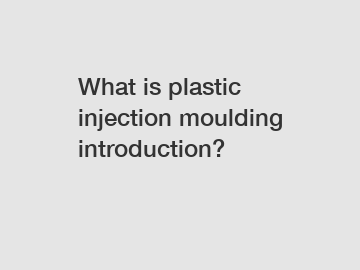What is plastic injection moulding introduction?
Plastic injection molding is a widely used manufacturing process that involves the production of plastic parts by injecting molten plastic material into a mold cavity. This cost-effective and efficient method has revolutionized the manufacturing industry, allowing for the production of complex and high-quality plastic parts at large volumes. But what exactly is plastic injection molding, and how does it work? Let's delve deeper into this fascinating process to understand its key aspects.
1. Definition and Process:
Plastic injection molding is a manufacturing technique that involves injecting molten plastic material, typically in the form of pellets or granules, into a specially designed mold. The mold is made of two halves, the "core" and the "cavity," which are separated to allow the molten plastic to enter the cavity and form the desired shape. The plastic is injected under high pressure and temperature, ensuring it fills the mold completely and solidifies rapidly.

2. Mold Design and Tooling:
The success of plastic injection molding greatly depends on the design and construction of the mold. Each mold must be meticulously designed, taking into account factors such as part geometry, material flow, cooling channels, ejection mechanism, and surface finish requirements. The molds are typically made from steel or aluminum and require high precision to produce accurate and consistent parts.
3. Material Selection:
A wide variety of plastic materials can be used in injection molding, including thermoplastics and thermosetting polymers. Thermoplastics, like polypropylene, polyethylene, and polystyrene, are the most commonly used materials due to their versatility and recyclability. Material selection depends on the desired properties of the final part, such as strength, flexibility, durability, or transparency.
4. Equipment and Machine Components:
Plastic injection molding machines consist of three primary components: the injection unit, the mold, and the clamping unit. The injection unit melts and injects the plastic into the mold, while the clamping unit securely holds the mold halves together during the injection process. The machines operate under high precision and control, ensuring consistent and accurate part production.
5. Advantages of Plastic Injection Molding:
Plastic injection molding offers numerous advantages over other manufacturing processes, including:
- Efficiency and Mass Production: Injection molding enables the rapid production of large volumes of identical parts, ensuring cost-effectiveness and scalability.
- Complex Geometries: The ability of injection molding to create intricate and complex part designs is unmatched by other methods. It allows for the integration of multiple features, such as ribs, holes, threads, and undercuts, in a single manufacturing step.
- Tight Tolerances: With injection molding, it is possible to achieve tight tolerances and high precision, resulting in consistent and accurate parts.
- Cost-Effective: Although the initial tooling costs can be high, the per-unit cost decreases significantly with larger production runs. This makes injection molding cost-effective for large-scale manufacturing.
- Material Versatility: Injection molding supports a wide range of plastic materials, providing flexibility in material selection based on the application and desired properties of the finished product.
6. Applications of Plastic Injection Molding:
Plastic injection molding finds application in various industries, including automotive, electronics, packaging, medical, and consumer goods. It is used to manufacture components such as automotive dashboards, electrical connectors, bottle caps, medical devices, and household appliances.
In conclusion, plastic injection molding is an essential manufacturing process that has revolutionized the production of plastic parts. Its efficiency, versatility, and ability to produce complex geometries make it a preferred choice for many industries. Understanding the basics of plastic injection molding, including the process, mold design, material selection, equipment, and the advantages it offers, is crucial for manufacturers and designers looking to produce high-quality plastic parts efficiently.
For more lightweight Polypropylene sheets Wholesale, Oem Injection Molded Plastic Parts China, Plastic Cnc Machininginformation, please contact us. We will provide professional answers.

Comments